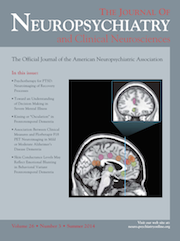To the Editor: The C9orf72 hexanucleotide repeat expansion found in some cases of motor neuron disease and behavioral variant frontotemporal dementia may be associated with psychiatric symptomatology, in particular with florid delusions. However, this mutation has not been found in patients with schizophrenia. The authors report on a patient with a provisional diagnosis of undifferentiated schizophrenia (DSM-IV-TR criteria) who, 4 years after diagnosis, developed neurological symptoms and signs, leading to definitive genetic diagnosis.
DSM-IV included a diagnostic category of undifferentiated schizophrenia as a catch-all for patients who failed to meet criteria for other schizophrenia subtypes (paranoid, disorganized, catatonic). As such, its differential diagnosis was likely to be broad. DSM-V has abandoned schizophrenia subtypes because of their perceived limited diagnostic stability, low reliability, and poor validity. The authors report on a patient with a provisional diagnosis of undifferentiated schizophrenia (DSM-IV-TR criteria) who eventually developed neurological symptoms and signs, leading to definitive genetic diagnosis.
Case Report
A 48-year-old man was noted by the care staff in his nursing home to have reduced use of his left hand and arm, progressing over 1 month and prompting neurological referral.
He had been a resident in the nursing facility for around 3 years, with a provisional diagnosis of undifferentiated schizophrenia. This diagnosis had been based on a progressive decline in professional occupational function and change of personality from outgoing to apathy and social withdrawal. There was no prior psychiatric history. The attending psychiatrists judged that there were no first-rank symptoms, but the patient did transiently express the view that he was a hermaphrodite because he had a female brain capable of multitasking. There were also some strange behaviors, particularly impulsivity when eating and shopping. He became both bowel and bladder incontinent.
At the time of neurological referral, he required assistance with all activities of daily living. His only medical treatments were sertraline 50 mg/day and clozapine 300 mg/day. The patient himself could contribute little historical information, giving only yes/no answers.
Salient findings on neurological examination were left wrist drop, wasted musculature in the left arm, fasciculations in the biceps muscles, and hyperreflexia throughout, with extensor plantar responses. There was hypomimia and some mild dysarthria, but cranial nerves were otherwise intact, and there were no parkinsonian signs.
Investigations showed a normal blood creatine kinase level, but neurophysiological studies were abnormal, with widespread active denervation and fasciculations on electromyography, consistent with an anterior horn cell disorder.
On the basis of the history and clinical and investigational findings, a diagnosis of frontotemporal dementia with motor neuron disease was suspected. Consent for neurogenetic testing was obtained, and the abnormal C9orf72 GGGGCC hexanucleotide repeat expansion was detected, confirming the clinical diagnosis of frontotemporal dementia with motor neuron disease. No family history of dementia or motor neuron disease was forthcoming.
Discussion
Hexanucleotide repeat expansions in the C9orf72 gene on chromosome 9p were first described in association with frontotemporal dementia, motor neuron disease, and frontotemporal dementia with motor neuron disease overlap syndrome in 2011.
1,2 This expansion is the most common genetic cause of frontotemporal dementia, accounting for more than 20% of familial cases and 5% of sporadic cases.
The clinical phenotype of C9orf72 expansions has been associated with a number of neuropsychiatric features.
3 For example, in a patient cohort from the United Kingdom, it was noted that 38% of mutation carriers presented with florid psychotic symptoms, for which initial psychiatric diagnoses of delusional psychosis, somatoform psychosis, and paranoid schizophrenia had been made. An additional 28% had paranoid, delusional, and irrational thinking. Delusions were much more common than hallucinations
4; these may sometimes be bizarre in form.
5 The mutation has on occasion been associated with obsessive compulsive disorder
6 and bipolar disorder.
7,8 Although a schizophrenia-like phenotype has been reported in frontotemporal dementia,
4,9 a study of schizophrenia patients identified no examples of C9orf72 expansion.
10This case illustrates the potential for the C9orf72 mutation to present to psychiatric services without overt neurological features. No neuropsychological assessment was undertaken at initial presentation, which might potentially have shown impairments of frontal lobe function. This diagnosis may need to be considered in young patients with psychiatric symptoms whom might previously have been diagnosed with undifferentiated schizophrenia. The observations in this case are consistent with the policy of DSM-V to abandon the category of undifferentiated schizophrenia.

